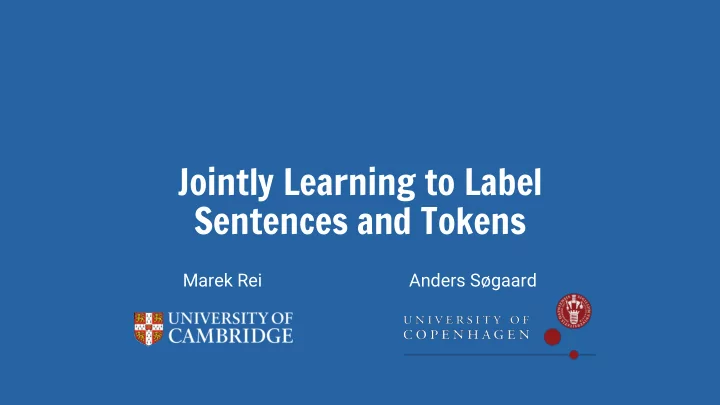

Jointly Learning to Label Sentences and Tokens Marek Rei Anders Søgaard 1/12
Task 1: Sentence Classification Error Detection It was so long time to wait in the theatre . I like to playing the guitar and sing very louder . This is a great opportunity to learn more about whales . Therefore, houses will be built on high supports . Sentiment Analysis The whole experience exceeded our expectations . Tom Hanks gave a fantastic performance as the lead . Sundance fans always try to find the Next Great Thing . The movie takes some time to come to the conclusion . 2/12
Task 2: Sequence Labeling Error Detection - - - X - - - - - X - I like to playing the guitar and sing very louder . Sentiment Analysis - - - - X - - - - - Tom Hanks gave a fantastic performance as the lead . 3/12
Main Idea Join together predictions on both sentences and tokens 01 Token-level predictions act as self-attention weights 02 Teaching the model where it should be focusing in the 03 sentence 4/12
Model Architecture Make token-level prediction scores also function as sentence-level attention weights. 5/12
Soft Attention Weights Based on sigmoid + normalisation: Token-level prediction Self-attention weight We can constrain the attention values based on the sentence-level label. 6/12
Language Modeling Objectives 1. Jointly training the network as a language model. Predicting the previous and the next word in the sequence. 2. Same principle extended to characters. Predicting the middle word based on characters of the surrounding words. 7/12
Evaluation CoNLL 2010 (Farkas et al., 2010) Detecting speculative (hedged) language. Shared task dataset, containing sentences from biomedical papers. FCE (Yannakoudakis et al., 2011) Detecting grammatically incorrect phrases and sentences. Error-annotated essays written by language learners. Stanford Sentiment Treebank (Socher et al., 2013) Detecting sentiment in movie reviews. Split into positive and negative sentiment detection. 8/12
Results: Sentence Classification Supervision on the token level explicitly teaches the model where to focus for sentence classification. 9/12
Results: Sequence Labeling Supervision on the sentence level regularizes the sequence labeler and encourages it to predict jointly consistent labels. 10/12
Conclusion Token-level labels can be used to supervise the attention 01 module for sentence-level composition Sentence-level labels can be used to regularize the token-level 02 predictions Language modeling objectives on tokens and characters help 03 the model learn better composition functions The result is a robust sentence classifier that is able to point to 04 individual tokens to explain its decisions 11/12
Thank you! Any questions? 12/12
Recommend
More recommend